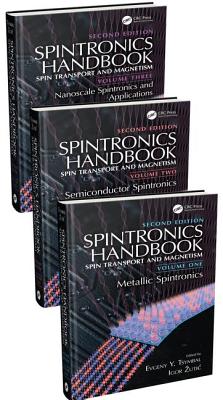Spintronics Handbook, Second Edition: Nanoscale Spintronics and Applications - Volume Three
暫譯: 自旋電子學手冊(第二版):納米尺度自旋電子學與應用 - 第三卷
Tsymbal, Evgeny Y., Zutic, Igor
- 出版商: CRC
- 出版日期: 2019-06-28
- 售價: $7,780
- 貴賓價: 9.5 折 $7,391
- 語言: 英文
- 頁數: 648
- 裝訂: Hardcover - also called cloth, retail trade, or trade
- ISBN: 1498769705
- ISBN-13: 9781498769709
海外代購書籍(需單獨結帳)
商品描述
Spintronics Handbook, Second Edition offers an update on the single most comprehensive survey of the two intertwined fields of spintronics and magnetism, covering the diverse array of materials and structures, including silicon, organic semiconductors, carbon nanotubes, graphene, and engineered nanostructures. It focuses on seminal pioneering work, together with the latest in cutting-edge advances, notably extended discussion of two-dimensional materials beyond graphene, topological insulators, skyrmions, and molecular spintronics. The main sections cover physical phenomena, spin-dependent tunneling, control of spin and magnetism in semiconductors, and spin-based applications.
Features:
- Presents the most comprehensive reference text for the overlapping fields of spintronics (spin transport) and
magnetism. - Covers the full spectrum of materials and structures, from silicon and organic semiconductors to carbon nanotubes, graphene, and engineered nanostructures.
- Extends coverage of two-dimensional materials beyond graphene, including molybdenum disulfide and study of their spin relaxation mechanisms
- Includes new dedicated chapters on cutting-edge topics such as spin-orbit torques, topological insulators, half metals, complex oxide materials and skyrmions.
- Discusses important emerging areas of spintronics with superconductors, spin-wave spintronics, benchmarking of spintronics devices, and theory and experimental approaches to molecular spintronics.
Evgeny Tsymbal's research is focused on computational materials science aiming at the understanding of fundamental properties of advanced ferromagnetic and ferroelectric nanostructures and materials relevant to nanoelectronics and spintronics. He is a George Holmes University Distinguished Professor at the Department of Physics and Astronomy of the University of Nebraska-Lincoln (UNL), Director of the UNL's Materials Research Science and Engineering Center (MRSEC), and Director of the multi-institutional Center for NanoFerroic Devices (CNFD).
Igor Zutic received his Ph.D. in theoretical physics at the University of Minnesota. His work spans a range of topics from high-temperature superconductors and ferromagnetism that can get stronger as the temperature is increased, to prediction of various spin-based devices. He is a recipient of 2006 National Science Foundation CAREER Award, 2005 National Research Council/American Society for Engineering Education Postdoctoral Research Award, and the National Research Council Fellowship (2003-2005). His research is supported by the National Science Foundation, the Office of Naval Research, the Department of Energy, and the Airforce Office of Scientific Research.
商品描述(中文翻譯)
《自旋電子學手冊,第二版》提供了自旋電子學和磁學這兩個交織領域的最全面調查的最新資訊,涵蓋了各種材料和結構,包括矽、有機半導體、碳納米管、石墨烯以及工程納米結構。該書專注於開創性的基礎研究,並結合最新的前沿進展,特別是對於超越石墨烯的二維材料、拓撲絕緣體、斯基爾米翁(skyrmions)和分子自旋電子學的擴展討論。主要部分涵蓋物理現象、自旋依賴隧穿、半導體中自旋和磁性的控制,以及基於自旋的應用。
特色:
- 提供自旋電子學(自旋傳輸)和磁學重疊領域的最全面參考文本。
- 涵蓋從矽和有機半導體到碳納米管、石墨烯和工程納米結構的全範圍材料和結構。
- 擴展對超越石墨烯的二維材料的涵蓋,包括二硫化鉬及其自旋鬆弛機制的研究。
- 包含關於尖端主題的新專章,如自旋-軌道扭矩、拓撲絕緣體、半金屬、複雜氧化物材料和斯基爾米翁。
- 討論自旋電子學中重要的新興領域,包括超導體、自旋波自旋電子學、自旋電子設備的基準測試,以及分子自旋電子學的理論和實驗方法。
Evgeny Tsymbal的研究專注於計算材料科學,旨在理解與納米電子學和自旋電子學相關的先進鐵磁和鐵電納米結構及材料的基本特性。他是內布拉斯加-林肯大學(UNL)物理與天文系的喬治·霍姆斯大學傑出教授,UNL材料研究科學與工程中心(MRSEC)的主任,以及多機構納米鐵電器件中心(CNFD)的主任。
Igor Zutic在明尼蘇達大學獲得理論物理學博士學位。他的研究涵蓋從高溫超導體和隨著溫度升高而增強的鐵磁性到各種自旋基設備的預測等多個主題。他是2006年國家科學基金會CAREER獎、2005年國家研究委員會/美國工程教育學會博士後研究獎的獲得者,以及2003-2005年國家研究委員會獎學金的獲得者。他的研究得到了國家科學基金會、海軍研究辦公室、能源部和空軍科學研究辦公室的支持。
作者簡介
Evgeny Y. Tsymbal is a George Holmes University Distinguished Professor
at the Department of Physics and Astronomy of the University of Nebraska-
Lincoln (UNL), and Director of the UNL's Materials Research Science and
Engineering Center (MRSEC). He joined UNL in 2002 as an Associate
Professor, was promoted to a Full Professor with Tenure in 2005 and named
a Charles Bessey Professor of Physics in 2009 and George Holmes University
Distinguished Professor in 2013. Prior to his appointment at UNL, he was a
research scientist at University of Oxford, United Kingdom, a research fellow
of the Alexander von Humboldt Foundation at the Research Center-Ju lich,
Germany, and a research scientist at the Russian Research Center " Kurchatov
Institute," Moscow. Evgeny Tsymbal's research is focused on computational
materials science aiming at the understanding of fundamental properties of
advanced ferromagnetic and ferroelectric nanostructures and materials relevant
to nanoelectronics and spintronics. He has published over 230 papers,
review articles, and book chapters and presented over 180 invited presentations
in the areas of spin transport, magnetoresistive phenomena, nanoscale magnetism,
complex oxide heterostructures, interface magnetoelectric phenomena,
and ferroelectric tunnel junctions. Evgeny Tsymbal is a fellow of the American
Physical Society, a fellow of the Institute of Physics, UK, and a recipient of the
UNL's College of Arts & Sciences Outstanding Research and Creativity Award
(ORCA). His research has been supported by the National Science Foundation,
Semiconductor Research Corporation, Office of Naval Research, Department of
Energy, Seagate Technology, and the W. M. Keck Foundation.
Igor Zutic received his Ph.D. in theoretical physics at the University of
Minnesota, after undergraduate studies at the University of Zagreb, Croatia.
He was a postdoc at the University of Maryland and the Naval Research Lab.
In 2005 he joined the State University of New York at Buffalo as an Assistant
Professor of Physics and got promoted to an Associate Professor in 2009 and
to a Full Professor in 2013. He proposed and chaired Spintronics 2001:
International Conference on Novel Aspects of Spin-Polarized Transport
and Spin Dynamics, at Washington DC. Work with his collaborators spans a
range of topics from high-temperature superconductors, Majorana fermions,
proximity effects, van der Waals materials, and unconventional magnetism,
to the prediction and experimental realization of spin-based devices that are
not limited to magnetoresistance. He has published over 100 refereed articles
and given over 150 invited presentations on spin transport, magnetism, spintronics,
and superconductivity. Igor Z utic is a recipient of the 2006 National
Science Foundation CAREER Award, the 2005 National Research Council/
American Society for Engineering Education Postdoctoral Research Award,
and the National Research Council Fellowship (2003- 2005). His research is
supported by the National Science Foundation, the Office of Naval Research,
the Department of Energy, the Defense Advanced Research Project Agency,
and the Airforce Office of Scientific Research. He is a fellow of the American
Physical Society.
作者簡介(中文翻譯)
**Evgeny Y. Tsymbal** 是內布拉斯加-林肯大學(University of Nebraska-Lincoln, UNL)物理與天文學系的喬治·霍姆斯大學傑出教授,並擔任UNL材料研究科學與工程中心(Materials Research Science and Engineering Center, MRSEC)的主任。他於2002年加入UNL,擔任副教授,並於2005年晉升為終身正教授,2009年被任命為查爾斯·貝西物理學教授,2013年成為喬治·霍姆斯大學傑出教授。在加入UNL之前,他曾是英國牛津大學的研究科學家,德國尤利希研究中心的亞歷山大·馮·洪堡基金會研究員,以及俄羅斯庫爾恰托夫研究所的研究科學家。Evgeny Tsymbal的研究專注於計算材料科學,旨在理解先進鐵磁和鐵電納米結構及材料的基本特性,這些材料與納米電子學和自旋電子學相關。他已發表超過230篇論文、評論文章和書籍章節,並在自旋傳輸、磁阻現象、納米尺度磁性、複雜氧化物異質結構、界面磁電現象和鐵電隧道接合等領域進行了超過180次的邀請報告。Evgeny Tsymbal是美國物理學會的會士,英國物理學會的會士,以及UNL文理學院傑出研究與創新獎(Outstanding Research and Creativity Award, ORCA)的獲得者。他的研究得到了國家科學基金會、半導體研究公司、海軍研究辦公室、能源部、西部數據科技公司和W. M. Keck基金會的支持。
**Igor Zutic** 在明尼蘇達大學獲得理論物理學博士學位,之前在克羅埃西亞的薩格勒布大學完成本科學業。他曾在馬里蘭大學和海軍研究實驗室擔任博士後研究員。2005年,他加入紐約州立大學水牛城分校,擔任物理學助理教授,並於2009年晉升為副教授,2013年晉升為正教授。他提議並主持了2001年在華盛頓特區舉行的自旋電子學國際會議:自旋極化傳輸和自旋動力學的新方面。與他的合作者的工作涵蓋了從高溫超導體、馬約拉納費米子、鄰近效應、范德瓦爾斯材料和非常規磁性,到預測和實驗實現不僅限於磁阻的自旋基設備等一系列主題。他已發表超過100篇經過審核的文章,並在自旋傳輸、磁性、自旋電子學和超導性等領域進行了超過150次的邀請報告。Igor Zutic是2006年國家科學基金會CAREER獎、2005年國家研究委員會/美國工程教育學會博士後研究獎和國家研究委員會獎學金(2003-2005)的獲得者。他的研究得到了國家科學基金會、海軍研究辦公室、能源部、國防高級研究計劃局和空軍科學研究辦公室的支持。他是美國物理學會的會士。










